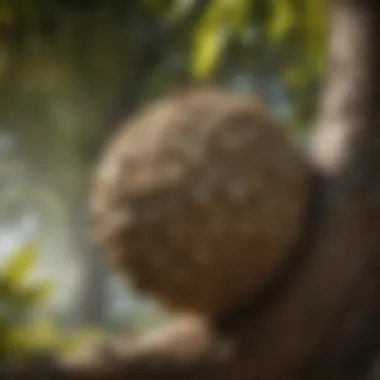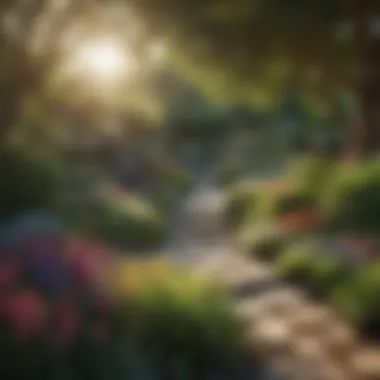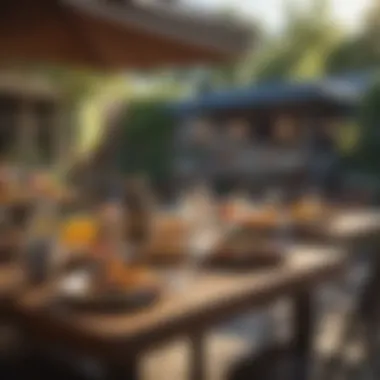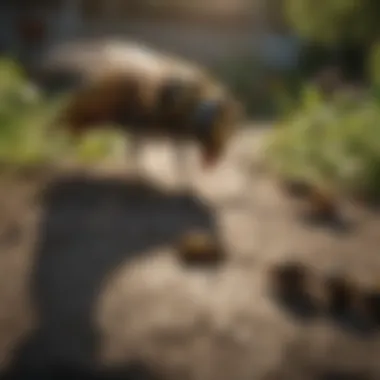Effective Strategies for a Wasp-Free Backyard


Preventive Pest Control Strategies
Effective pest control begins with preventive measures that can significantly reduce the chances of wasps making your backyard their home. Understanding the primary risk factors and addressing them proactively is essential in maintaining a comfortable outdoor space.
House Exterior Protection
Start by evaluating the exterior of your home. This is vital for keeping wasps away. Here are some basic yet impactful strategies:
- Tips for sealing cracks: Inspect the foundation, windows, and doors for any cracks or gaps. Use silicone caulk or weather stripping to seal these entry points. Wasps are drawn to even the smallest openings.
- Clearing debris: Regularly clean up your yard to remove nests and potential nesting sites.
- Preventing pests from entering: Keep plants trimmed and ensure that vents and chimneys are covered with fine mesh to prevent wasps from entering the house.
Yard Maintenance
Maintaining your yard can have a significant impact on reducing wasp populations. Some essential practices include:
- Essential yard care routines: Mow the lawn regularly, and keep bushes trimmed to discourage wasps from settling.
- Methods for keeping yard pest-free: Use flower and plant selections wisely. Avoid heavy fragrances or sweet-smelling blooms that attract wasps.
Indoor Cleanliness
Indoor spaces should also be kept clean to prevent attracting pests:
- Expert cleaning tips and techniques: Regular vacuuming and wiping surfaces can eliminate food crumbs. Make sure to clean under furniture.
- Maintaining a pest-resistant indoor environment: Store food in tightly sealed containers and promptly clean spills.
Garbage Disposal
Proper waste management is critical for reducing wasp attraction:
- Efficient waste disposal methods: Use covered trash cans outside. Make sure that garbage bins are emptied regularly to prevent any sweet residues from attracting pests.
- Importance of proper garbage disposal: Properly disposing of food waste helps eliminate easy food sources for wasps.
Other Pest Prevention Strategies
Innovative pest control strategies can make a difference:
- Innovative ways to safeguard your home: Consider using natural repellents, strategically placing traps, and planting specific herbs known to deter wasps, such as mint or basil. This approach blends aesthetic gardening with effective pest control.
"Preventing wasps from entering your living space should be a consistent effort. Regular maintenance can save you from larger problems later."
In sum, implementing these preventive measures requires diligent upkeep. By actively managing your home and yard, you create a less inviting environment for wasps and other pests.
Understanding Wasp Behavior
Understanding wasp behavior is crucial for homeowners who seek to manage and mitigate their presence in backyards. By grasping the intricacies of how wasps operate, one can devise effective strategies to create a more welcoming outdoor environment. Familiarity with this behavior aids in recognizing potential threats and addressing them proactively.
The significance of understanding wasp behavior lies not solely in avoidance, but also in the capacity to coexist with these insects while protecting personal spaces. Often, wasps are systematic and predictable, exhibiting behaviors linked to nesting, feeding, and social interaction. Knowledge in this domain can enhance efforts to deter wasps, making them essential for practical home management.
Types of Wasps Commonly Found
There are several types of wasps that homeowners might encounter. The most common include:
- Yellowjackets: These are small, aggressive wasps known for their social behavior. They build nests in the ground or in voids.
- Paper Wasps: Recognizable by their elongated bodies and long legs, they build open nests made of a papery substance. Typically, they are less aggressive unless provoked.
- Hornets: A subset of wasps, hornets are larger and tend to be more aggressive. They create large nests that can be in trees, shrubs, or buildings.
Recognizing these types allows for a targeted approach in addressing each species differently as they may require distinct management strategies.
Life Cycle of Wasps
The life cycle of wasps comprises four stages: egg, larva, pupa, and adult. Wasps usually emerge from their nests in spring. Initially, a fertilized queen creates a new nest and lays eggs. The larvae, upon hatching, are fed by the queen until they develop into adults. At this stage, they take on roles within the colony, aiding in feeding the larvae and building the nest. Understanding this life cycle is crucial as it provides insight into when wasps are most vulnerable and when management efforts should be focused.
By considering their life cycles, homeowners can implement strategies that coincide with critical phases in wasp development, enhancing the effectiveness of their prevention methods.


Attraction Factors for Wasps
Several factors may draw wasps to your backyard, which include:
- Food Sources: Wasps are attracted primarily to protein-rich foods such as meat or sugary substances found in drinks and fruits.
- Nesting Sites: Overgrown areas and sheltered spaces can serve as potential nesting sites.
- Standing Water: Locations with stagnant water can also attract wasps, as they require water for their nests.
By understanding these attraction factors, homeowners can take preventive measures, such as securing food sources and minimizing areas conducive to nesting. This knowledge allows for a proactive approach in creating a less inviting atmosphere for wasps.
Assessing Your Backyard Environment
In order to effectively reduce the presence of wasps in your backyard, it is critical to first assess and understand your environment. This process involves identifying factors that may attract wasps and understanding their nesting preferences. By conducting a thorough evaluation, you can implement strategic methods tailored to your specific circumstances. Such an assessment not only aids in controlling current wasp populations but also plays a vital role in preventing future infestations.
Identifying Wasp Nest Locations
Spotting potential wasp nest locations is a fundamental step in your preventative strategy. Wasps tend to build nests in sheltered areas. Common places include eaves, attics, or under decks. Observing characteristics like increased wasp activity during warm months can help identify nearby nests. Here are some steps to pinpoint these locations:
- Look for wasp activity near structures and plants. Wasps are often seen flying in and out of their nests.
- Check for existing nests. These can vary in size and may be hidden in hard-to-reach areas.
- Listen for buzzing sounds. A buzzing noise may indicate the presence of a nest nearby.
- Observe for nesting materials, like paper-like structures which indicate a wasp nest.
Proper identification of these nests provides a targeted approach for removal or treatment, minimizing the risk of stings and helping maintain a wasp-free environment.
Environmental Factors Encouraging Wasps
The environment around your backyard significantly affects the attraction of wasps. Several factors can create conditions that are ideal for these insects. Awareness of these factors allows homeowners to take proactive steps to mitigate them. Consider the following elements:
- Food Sources: Wasps can be drawn to easily accessible food, such as open cans, sugar spills, or pet food that remains outside.
- Water Sources: Standing water, such as bird baths or puddles, can attract wasps looking for hydration.
- Shelter: Dense vegetation or cluttered areas provide safe havens for wasps to build nests.
- Gardening Practices: Certain fruits, like overripe nectarines, can attract wasps.
By managing these factors, you can significantly reduce the likelihood of wasps frequenting your outdoor spaces and avoid unwanted encounters.
In focusing on these aspects, you create an environment less conducive to wasp habitation. The more you know about your backyard landscape and conditions, the easier it will be to implement effective strategies.
Preventative Strategies
Preventative strategies play a vital role in managing wasp populations in your backyard. Effective measures can limit the chances of wasps establishing their nests and becoming a persistent problem. Understanding these strategies allows homeowners to take proactive steps, ensuring not just the comfort of outdoor activities but also the safety of family and pets. The benefits of implementing these strategies are considerable. By investing time in prevention, you reduce the likelihood of encounters with wasps, thereby lessening the chances of painful stings.
Sealing Entry Points
Sealing entry points is an essential step in wasp prevention. Wasps tend to look for sheltered areas to build their nests, and your home's eaves, attics, or even small cracks in walls may offer the perfect environment. By inspecting these areas and sealing any potential entry points, you can drastically reduce the opportunities for wasps to invade your space.
Key actions to take include:
- Identify gaps: Look for openings in your home’s structure, focusing on areas around windows, doors, and vents.
- Use appropriate materials: Employ caulk or foam sealant to close gaps. These materials create a barrier that is difficult for wasps to penetrate.
- Regular maintenance: Make it a routine to check for new openings created by wear and tear, especially as seasons change.
By maintaining a sealed environment, you limit the chances of attracting wasps, making it less likely they will settle near your home.
Using Natural Repellents
Incorporating natural repellents is an effective and eco-friendly method to deter wasps from your backyard. Many homeowners prefer solutions that do not involve harsh chemicals, which may also impact other beneficial insects.
Some options to consider include:
- Peppermint oil: Its strong scent is known to repel wasps. Mixing a few drops with water in a spray bottle can create a simple repellent solution. Spray it around the yard, particularly near entry points like doors and windows.
- Vinegar: A vinegar spray can irritate wasps. A mixture of equal parts of water and vinegar sprayed on plants will dissuade them from approaching.
- Cucumber slices: Placing cucumber slices around your outdoor area can act as a natural deterrent, as wasps are not fond of this fruit.
Using these natural alternatives not only reduces the likelihood of wasps visiting but also promotes a healthier environment for your garden.
Traps and Lures for Wasp Control
Employing traps and lures for wasp control is another critical strategy for backyard management. This method aids in significantly decreasing the wasp population. Traps attract and capture these pests, removing them from the equation before they can nest.


Consider these trapping options:
- DIY traps: You can easily create a wasp trap using a plastic bottle. Cut the top off, invert it, and secure it to the base. Fill it with sugar water or fruit juice to lure the wasps inside. Seal the top to prevent their escape.
- Commercial traps: Various stores sell traps specifically designed for wasps. Look for options with wasp lures to ensure effectiveness. Position them away from high traffic areas to draw the wasps away from where people gather.
- Monitor effectiveness: Regularly check traps for captured wasps and replace bait as needed. Adjust the location of traps throughout the season based on wasp activity.
This proactive approach can yield immediate results, reducing the wasp population in your yard and ensuring a more peaceful outdoor experience.
Landscaping Considerations
Landscaping plays a crucial role in controlling the presence of wasps in your backyard. By choosing the right plants and maintaining a tidy garden, homeowners can significantly reduce the likelihood of attracting these insects. It is vital to understand that certain landscaping choices can either invite wasps or deter them. Thus, careful planning and execution of these choices can lead to a more enjoyable outdoor space.
Choosing Non-Attractive Plants
Selecting non-attractive plants is pivotal in creating a wasp-free garden. Certain flowers, fruits, and veggies attract wasps, often due to their nectar or rotting fruits which draw them in. It is advisable to consider these points while planning your garden:
- Avoid Nectar-Rich Flowers: Flowers such as asters, daisies, and zinnias can attract wasps. Opt instead for plants like rosemary, lavender, or sage which are less appealing to them.
- Fruit Trees and Berries: While delicious, fruit trees can be a magnet for wasps. Apples and pears releasing ripe fruits can bring wasps to your yard. Consider eliminating fruit trees or opting for less attractive varieties if you experience frequent wasp activity.
- Herb Gardens: Some homeowners choose to plant herbs that provide culinary benefits and are naturally unsavory to wasps. Basil and mint can work well for this purpose. These choices help in not only reducing wasp presence but also adding value to your kitchen.
Planting strategies thus involve a balance of aesthetic appeal and practical planning, leading to a garden that minimizes wasp activity.
Maintaining a Clean Garden
A clean garden is fundamental in becmoing uninviting to wasps. Debris and leftover food sources can inadvertently support a wasp population. Implement these practices to maintain cleanliness:
- Regularly Remove Debris: Fallen fruit, old mulch, or dry leaves can become potential breeding grounds for wasps. It is essential to inspect your garden regularly, ensuring that any organic matter is removed.
- Proper Waste Disposal: Ensure your trash bins are sealed tightly. Wasps are often attracted to open junk, especially if food remnants are present. Use containers with tight-fitted lids, and consider moving them further away from gathering spaces.
- Food Management During Gatherings: If hosting an outdoor meal, cover food and beverages. Wasps are opportunistic feeders and will be drawn to unprotected items. Keep an eye on spills and leftover food to ensure they do not attract unwanted guests.
By creating a structured approach to landscaping and maintaining a clean environment, homeowners can enjoy their backyards without the fear of wasps interrupting their activities.
Food Management Practices
Food management practices play a critical role in keeping wasps at bay, as these insects are highly attracted to food sources, especially sugary items and proteins. By understanding and implementing effective food management strategies, homeowners can significantly reduce the likelihood of wasp infestations in their backyards. This section outlines specific elements of waste management and outdoor dining precautions that contribute to a wasp-free environment.
Proper Waste Management
Proper waste management is crucial in deterring wasps. Uncovered trash bins and compost areas often become a paradise for these insects. To minimize attraction:
- Use Fitted Lids: Ensure that all garbage containers have tight-fitting lids. This simple step prevents wasps from accessing scraps and prevents odors that might draw them in.
- Regular Disposal: Dispose of trash regularly. Leaving waste to pile up only increases the potential for wasps to venture closer to your home.
- Choose the Right Containers: Opt for bins made from sturdy materials that are less likely to be breached by wasps searching for food.
- Secure Compost Bins: If you have a compost bin, make sure it is sealed. Adding waste material that’s less appealing, such as straw or dry leaves, may help cover up food scraps.
- Clean Spills Promptly: If food or drink spills occur in your outdoor area, clean them up immediately to avoid attracting wasps.
Taking these steps not only ensures a cleaner environment but greatly decreases the chances of wasps being drawn to your property.
Outdoor Dining Precautions
Outdoor dining can be an enjoyable experience, but it can also attract wasps if not managed properly. Here are some key precautions to follow:
- Limit Open Food Sources: When dining outside, keep food covered as much as possible. Using food domes or containers during meals can prevent wasps from discovering easy food sources.
- Avoid Sweet Beverages: Wasps are particularly drawn to sweet drinks like sodas and juices. Opt for covered drink containers or keep drinks sealed when not in use.
- Immediate Cleanup: After outdoor meals, promptly clear away all food and waste. This includes not leaving plates or dishes unattended, as wasps are quick to investigate.
- Use Natural Deterrents: Consider using natural deterrents such as citronella candles or essential oils, which can help dissuade wasps while allowing you to enjoy your outdoor space.
- Designate a Wasp-Friendly Zone: If wasps do appear during an outdoor gathering, have a designated area away from food where wasps can be less intrusive. This might allow guests to maintain a comfortable environment.
"Implementing sound food management practices significantly lowers the chances of attracting wasps, leading to a safer and more enjoyable outdoor space."
By thoughtfully managing food waste and taking precautions during outdoor dining, homeowners can create an environment that is much less inviting for wasps. These efforts contribute to a more pleasant backyard experience and enhance overall safety.
Monitoring and Maintenance
Effective monitoring and maintenance are crucial components in the quest to prevent wasps in your backyard. Keeping a close eye on wasp activity allows homeowners to take proactive measures before a problem escalates. It is not just about ensuring immediate safety; it is also about fostering a long-term strategy for backyard management. By instituting a regular routine of inspections, identifying potential wasp habitats, and adapting strategies seasonally, you set the stage for a more pleasant outdoor living environment.
Regular Inspections
Conducting regular inspections of your backyard is vital to prevent wasp nests from forming. Schedule checks at least every few weeks, especially during the warmer months when wasp activity peaks. Pay attention to:
- Eaves and Overhangs: Wasps often choose these locations for nest building. Inspect these areas for any signs of nests or wasp activity.
- Decks and Patios: Look under furniture and in sheltered corners where wasps may hide.
- Gardens: Check flowering plants and shrubs, as they attract wasps searching for nectar.


Identifying nests early is essential. The longer a nest remains untouched, the larger it can grow, creating a greater risk for stings. If you see small paper-like structures, it is time to take action. Regular inspection also builds awareness of wasp habits, which is key in managing your overall strategy effectively.
Adjusting Strategies Seasonally
Wasps have different behaviors and lifecycle phases throughout the year. As such, adapting your strategies according to the seasons is important for effective prevention.
In spring, wasps are establishing their colonies. This is the time to tighten your inspection schedule and proactively eliminate potential nesting sites. Consider using natural repellents at this stage, as the warming weather attracts them.
During summer, wasps become more aggressive. This is when they seek food sources. Your focus should shift to food management practices, ensuring that all outdoor dining areas are clean and waste is properly managed.
In the fall, wasps enter a feeding frenzy in preparation for winter. Redoubling efforts in cleaning up fallen fruits or unused food will help deter wasps from your yard. Additionally, preventive measures, like setting out traps, can reduce their numbers significantly before the end of the season.
By tailoring your actions based on seasonal shifts, you enhance your chances of maintaining a wasp-free environment. Visiting resources like Wikipedia or reading articles on Britannica can offer further insights into wasp behavior that may inform your seasonal strategy adjustments.
"Prevention is always better than cure. Engaging in consistent monitoring and adapting to changing circumstances can save you from potential problems later on."
By implementing these monitoring and maintenance strategies, you create a prudent barrier against wasp infestations, ensuring your backyard remains an enjoyable space for you and your family.
Understanding the Risks of Wasp Stings
Understanding the risks associated with wasp stings is crucial for any homeowner interested in maintaining a safe outdoor environment. Wasp stings can cause various health issues, ranging from mild discomfort to severe allergic reactions. Recognizing these risks helps individuals to prepare and respond effectively, reducing the chance of unfortunate incidents occurring in their backyards.
Health Implications of Wasp Stings
Wasp stings can lead to immediate pain and swelling. The venom injected during a sting contains a mix of toxins that provoke a physiological response in the body. Most people may experience localized pain, redness, and swelling at the sting site. In some cases, there are systemic reactions. These could include hives, difficulty breathing, nausea, and dizziness.
For individuals with allergies, the consequences can be more severe. Anaphylaxis is a life-threatening reaction that necessitates immediate medical attention. Individuals known to have such allergies should always carry an epinephrine auto-injector.
Closed reactions often result in the need for over-the-counter pain relief or an antihistamine. If symptoms persist or worsen, seeking medical help is vital. Awareness of these health implications can help in taking necessary precautions and prompt responses in case of an incident.
Emergency Response Protocols
In the event of a wasp sting, knowing how to respond can be vital. Here is a structured approach to handling wasp sting incidents:
- Assess the Situation: Determine if the sting victim is experiencing severe symptoms, such as swelling of the face, throat, or difficulty breathing.
- Move to Safety: If multiple wasps are present, ensure both the victim and others are away from the area to prevent further stings.
- Administer First Aid: For mild symptoms:
- Monitor Symptoms: Keep an eye on the victim’s condition. If symptoms escalate or serious reactions occur, call for emergency help immediately.
- Seek Medical Attention: Anyone with known allergies who gets stung should be evaluated by a medical professional, regardless of the severity of the sting.
- Remove the stinger if still lodged in the skin, by gently scraping with a flat object.
- Wash the sting site with soap and water.
- Apply a cold pack to reduce swelling and pain.
"Prevention is better than cure." Understanding and preparing for the risks of wasp stings not only aids in managing the situation effectively but also promotes a safer environment for everyone involved.
Being informed about the health implications and having clear protocols in place can significantly diminish the risks associated with wasps. By doing so, homeowners can enjoy their outdoor spaces with greater peace of mind.
Professional Intervention Options
Dealing with wasps in your backyard can be quite challenging. When you have tried various preventive measures without success, considering professional intervention can become necessary. It is important for homeowners to evaluate the resources and knowledge that pest control services can offer. These professionals possess the expertise and tools to tackle infestations effectively, minimizing potential risks associated with wasp stings and ensuring a safer environment for your family.
When to Call Pest Control
Knowing when to call a pest control service can save you time and frustration. If you notice a significant increase in wasp activity or find nests that are difficult to access, it might be time to seek professional help. Other signs that indicate the need for intervention include:
- Regular sightings of wasps near your living spaces.
- Disturbances or aggressive behavior from wasps when you are outside.
- Finding a nest in close proximity to children or pets.
Your safety should be the priority. Experienced pest control specialists can assess the situation efficiently and determine the best method for removal
"Calling a professional can provide peace of mind that you cannot obtain by trying to manage the issue yourself."
Understanding Treatment Methods
There are various methods used by professionals to manage wasp populations. Below are some common approaches:
- Chemical Treatments: Pest control companies often use insecticides designed specifically for wasps. These products can effectively eliminate nests, but they require careful application to avoid harm to humans and beneficial insects.
- Trapping Systems: Some services implement trapping strategies, using bait traps that attract and capture wasps. This method can reduce local populations over time.
- Nest Removal: In cases where the nest location is accessible, professionals can remove nests directly. They will wear protective gear and use specialized equipment to ensure safe removal.
You should always discuss treatment options with your pest control provider. Understanding their process and expected outcomes can guarantee that you are comfortable with their methods.



